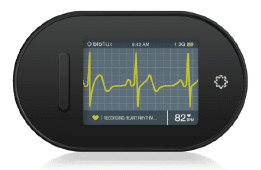MedicalResearch.com Interview with:
Waqaas Al-Siddiq
Founder and CEO of
Biotricity Inc
MedicalResearch.com: In light of Apple's announcement that it will incorporate an EKG monitoring device into Apple watches in the near future, would you discuss your vision of the growing medical wearables market?
Response: First of all, the public is still largely confused as to what constitutes a medical wearable device. Apple’s new watch, with its EKG monitoring service, is not a medical wearable because it will not produce clinical-grade data needed for diagnosis or treatment. This is not to say that Apple’s watch isn’t helpful. Many people are not even aware that they have a heart problem, but if their Apple watch consistently tells them that they have an irregular heart rhythm, or arrhythmia, they could take that as a sign to go to a physician and get a professional diagnosis. A physician will then prescribe a medical wearable device, such as our
Bioflux, to monitor the patient’s heart rhythm. Medical-grade wearable devices produce clinical-grade data that is accurate to within 90-95 percent or higher and are prescribed by physicians to make diagnoses and treatment plans.
That being said, I envision that the medical wearables market will expand considerably with the advent of consumer-based wearables that facilitate health tracking. One of the biggest problems we have today is a lack of awareness. Anywhere between 2.7 and 6.1 million people in the U.S. suffer from atrial fibrillation - a condition that makes the heart beat
irregularly - and many aren’t aware that they have the condition. Consumer-based health trackers like the Fitbit and the Apple Watch can help raise awareness and alert consumers to possible health issues, which will encourage them to see a physician for a thorough and professional examination and diagnosis. This, in turn, gives the medical wearable market a boost as more people will be diagnosed with the aid of a medical wearable. Another factor that is playing into this adoption trend is that next-generation medical wearables are increasingly becoming smaller and easier to use for both patients and physicians. So, I think that the future of medical wearables will see them firmly entrenched in mainstream practice and eventually become tools within the home for individuals with chronic issues.
(more…)
 Keeping up with the fitness sector isn't as easy as it seems, especially when new trends and tech emerge daily. Fitness apps are on the rise, but how do you remain ahead of the competition and provide actual value to users?
Fitness buffs today want more than a workout logging tool. They want data-driven insights, tailored recommendations, and wearable integration. Ignoring these features could lead to your app being uninstalled, along with many others. So, fitness wearables aren't merely devices; they're integral parts of the app ecosystem. You're setting a new standard by integrating your fitness app with wearables. To ensure that your fitness app is ready for the future, it is important to incorporate real-time data, user involvement, and personalized experiences. All this is made possible by smart wearables. Let's look at why adopting wearables can completely transform your app development strategy.
(more…)
Keeping up with the fitness sector isn't as easy as it seems, especially when new trends and tech emerge daily. Fitness apps are on the rise, but how do you remain ahead of the competition and provide actual value to users?
Fitness buffs today want more than a workout logging tool. They want data-driven insights, tailored recommendations, and wearable integration. Ignoring these features could lead to your app being uninstalled, along with many others. So, fitness wearables aren't merely devices; they're integral parts of the app ecosystem. You're setting a new standard by integrating your fitness app with wearables. To ensure that your fitness app is ready for the future, it is important to incorporate real-time data, user involvement, and personalized experiences. All this is made possible by smart wearables. Let's look at why adopting wearables can completely transform your app development strategy.
(more…) Keeping up with the fitness sector isn't as easy as it seems, especially when new trends and tech emerge daily. Fitness apps are on the rise, but how do you remain ahead of the competition and provide actual value to users?
Fitness buffs today want more than a workout logging tool. They want data-driven insights, tailored recommendations, and wearable integration. Ignoring these features could lead to your app being uninstalled, along with many others. So, fitness wearables aren't merely devices; they're integral parts of the app ecosystem. You're setting a new standard by integrating your fitness app with wearables. To ensure that your fitness app is ready for the future, it is important to incorporate real-time data, user involvement, and personalized experiences. All this is made possible by smart wearables. Let's look at why adopting wearables can completely transform your app development strategy.
(more…)
Keeping up with the fitness sector isn't as easy as it seems, especially when new trends and tech emerge daily. Fitness apps are on the rise, but how do you remain ahead of the competition and provide actual value to users?
Fitness buffs today want more than a workout logging tool. They want data-driven insights, tailored recommendations, and wearable integration. Ignoring these features could lead to your app being uninstalled, along with many others. So, fitness wearables aren't merely devices; they're integral parts of the app ecosystem. You're setting a new standard by integrating your fitness app with wearables. To ensure that your fitness app is ready for the future, it is important to incorporate real-time data, user involvement, and personalized experiences. All this is made possible by smart wearables. Let's look at why adopting wearables can completely transform your app development strategy.
(more…)

